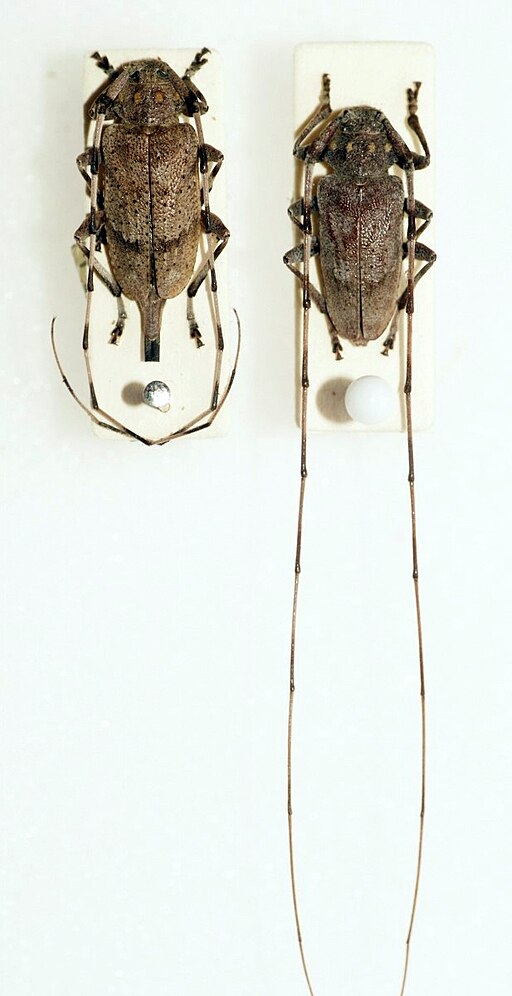Superregnum: Eukaryota
Regnum: Animalia
Subregnum: Eumetazoa
Cladus: Bilateria
Cladus: Nephrozoa
Cladus: Protostomia
Cladus: Ecdysozoa
Cladus: Panarthropoda
Phylum: Arthropoda
Subphylum: Hexapoda
Classis: Insecta
Cladus: Dicondylia
Subclassis: Pterygota
Ordo: Coleoptera
Subordo: Polyphaga
Infraordo: Cucujiformia
Cladus: Phytophaga
Superfamilia: Chrysomeloidea
Familia: Cerambycidae
Subfamilia: Lamiinae
Tribus: Acanthocinini
Genus: Acanthocinus
Species: Acanthocinus aedilis
Name
Acanthocinus aedilis (Linnaeus, 1758)
Combinations
Cerambyx aedilis (Original combination)
Vernacular names
Deutsch: Zimmermannsbock
English: Timberman beetle
suomi: Sarvijaakko
magyar: Nagy daliáscincér
polski: Tycz cieśla
русский: Серый длинноусый усач / Длинноусый дровосек
svenska: Timmerman
References
Linnaeus, C. 1758. Systema Naturae per regna tria naturæ, secundum classes, ordines, genera, species, cum characteribus, differentiis, synonymis, locis, Tomus I. Editio decima, reformata. Holmiæ: impensis direct. Laurentii Salvii. i–ii, 1–824 pp DOI: 10.5962/bhl.title.542: 392. Reference page.
Links
Acanthocinus aedilis Taxon details on Fauna Europaea
Tribe Acanthocinini: Acanthocinus aedilis (Linnaeus, 1758) - photos by Dmitry Telnov
ZooBank: 849C7607-4628-4D22-8C48-8AD1A544FCB7
The timberman beetle (Acanthocinus aedilis) is a species of beetle belonging to the longhorn beetle family,[1] which is a woodboring beetle.
It is found in woodlands in with a large distribution through Europe, Russia and Central Asia. It is also known as the Siberian Timberman due to its range extending northwards in to Siberia.[2] In Finnish this species is known as Sarvijaakko, in Dutch as Dennenboktor and in Swedish as Större Timmerman.[3] For more vernacular names see the GBIF profile.[4] Despite a few sources suggesting reports in Central America, no confirmed reports were available at time of editing (May, 2020). The species is also not listed as invasive in North America.[5]
The body length ranges from 12-20mm, with antennae up for 3 times the body length in males, or 1.5 times the body length in females.[2] Their lifespan is up to 3 years which includes the 1–2 years spent in the larval stage.[6]
This species is capable of surviving freezing temperatures below -37 °C in both the adult and larval stages.[7] The adults are active from March to June, during which they are diurnal.[2] The adults overwinter in pupal chambers in leaf litter or under the bark.[8]
In Continental Europe, this species has become a serious pest of commercially-grown timber as the larvae feed under the bark, weakening the trees.[2] Through infesting weakened trees, excavating galleries under the bark, the trees then die.[8] Their development within wood debris in natural forests is beneficial for nutrient cycling in forest ecosystems, but can also facilitate the transfer of pathogenic fungi within woodlands.[9] Scots pine (Pinus sylvestris L.) and Norway Spruce (Picea abies) are key food sources for this beetle species.[1]
A distribution map within the UK can be found courtesy of the National Biodiversity Network.[10][11] The species is reported to be Nationally Scarce category B within Great Britain by the Wildlife Trust BCN in 2018.
References
https://eol.org/pages/118244
https://www.ukbeetles.co.uk/acanthocinus-aedilis
http://www.eu-nomen.eu/portal/taxon.php?GUID=urn:lsid:faunaeur.org:taxname:114036
https://www.gbif.org/species/10595482
https://www.invasive.org/browse/subinfo.cfm?sub=10205
https://www.uksafari.com/longhorn_timberman.htm
Kristiansen E, Li NG, Averensky AI, Laugsand AE, Zachariassen KE. The Siberian timberman Acanthocinus aedilis: a freeze-tolerant beetle with low supercooling points. J Comp Physiol B. 2009;179(5):563‐568. doi:10.1007/s00360-009-0340-x
https://wiki.bugwood.org/Archive:Atlas/Acanthocinus_aedilis
Meshkova, Valentyna & I., Kochetova & Ye, Skrylnik & Zinchenko, O.. (2017). Seasonal development of the timberman beetle Acanthocinus aedilis (Linnaeus, 1758) (Coleoptera: Cerambycidae) in the North-Eastern Steppe of Ukraine. Annals of the Entomological Society of America. 25.
https://www.coleoptera.org.uk/species/acanthocinus-aedilis
https://species.nbnatlas.org/species/NBNSYS0000011056
Retrieved from "http://en.wikipedia.org/"
All text is available under the terms of the GNU Free Documentation License


